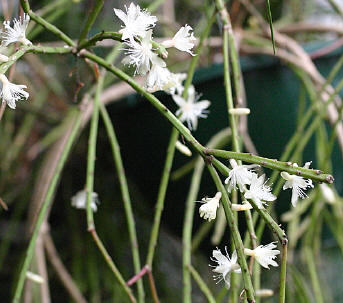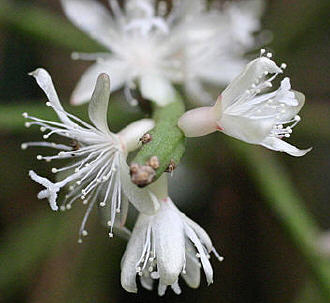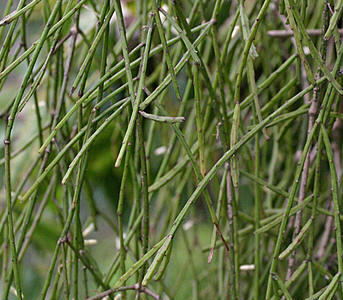Rhipsalis ewaldiana Barthlott and Taylor in Bradleya 13 (1995)
 |
 |
|
Photos © Ken Friedman |
||
Desc from Bradleya 13
- Plant - stems dimorphic, the primary axes up to 600 x 4-5 mm, of indeterminate growth, 4-angled; secondary stem-segments similar, but only 30-60 mm long, mostly 3-angled, arising in mesotonic position and of determinate growth.
- Flowers - lateral on the secondary stem-segments, reddish in bud, 14-20 mm diam. at anthesis, white within.
- Fruit - pinkish, c. 8 mm diam.
DISTRIBUTION. Brazil (Rio de Janeiro): Serra dos Orgaos?
This new species is so distinct that we have decided to describe it even though its exact wild provenance is not certainly known. It may originate from the Serra dos Orgaos, since staff of the Cactario, Jardim Botanico, Rio de Janeiro, obtained it from a nursery located on the road between Terespolis and Nova Friburgo. At first sight it could be mistaken for R. teres f. prismatica, but its stems are stouter and much more strongly angular. Its peculiar habit is matched only in R. mesembryanthemoides, which is much smaller in all its parts. Its flowers are also similar to that species and both seem to flower sporadically throughout the year (with a maximum in autumn and spring).
The plant was first received at Heidelberg in 1971 from the collection of J. Marnier-Lapostolle (Jardin Botanique 'Les Cedres', St Jean Cap Ferrat, France); later it arrived again from a Belgian horticulturist, and finally in 1985 from Ernst Ewald (Hamburg), who claimed it to be the "true R. prismatica." However, after lengthy correspondence it was agreed that it must be an undescribed species, although its wild origin remained unknown, all specimens received being traceable only to old horticultural collections in France. One could speculate that it entered European cultivation as one of the many introductions which passed through the hands of Dr. Albert Weber (Paris) around the close of the last century. To date no herbarium collections of either wild or cultivated origin have been located.
We have considered the possibility that it is a hybrid involving R. mesembryanthemoides and a species with winged or angled stems, but this seems improbable, given that no other interspecific hybrids in Rhipsalis have been documented to date. However, should it prove to be a hybrid after all, it is so distinct that it would still require a name, and that provided here in accordance with the Botanical Code (ICBN) can easily be converted and used as a cultivar name under the Cultivated Code (ICNCP).
It is named for Ernst Ewald (Hamburg), an enthusiastic collector of epiphytic cacti, who recognized it as something unusual and then kindly sent it to the University of Bonn for study.
----------------------------
Comment from Peter Krebs: Here in Europe Rh. ewaldiana has been in the trade for a number of years, usually without name. I got mine 10 years ago and have seveal specimens now which I have had growing under various conditions (my "hobby": to see how Rhipsalis grow under various conditions and what forms they take). My Rh. ewaldiana grown under strong light develop flowers with a rose center and with rose to red ovary and then they look very similar to those shown with the original description in Bradleya 1995, p. 53, plate 18. When grown with less light, the flowers tend to be pure white and the ovary is white to very slightly rose, as seen on the Rhipsalis site. By the way, my specimens are self-incompatible

